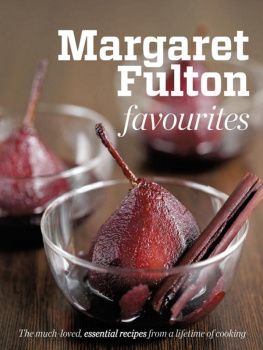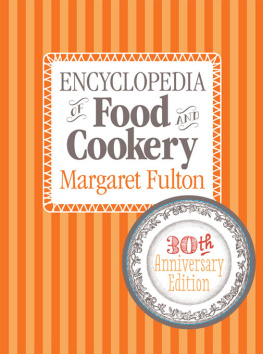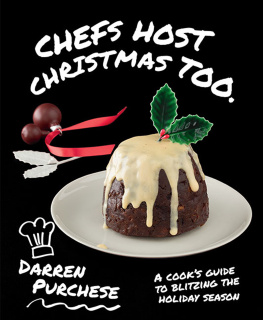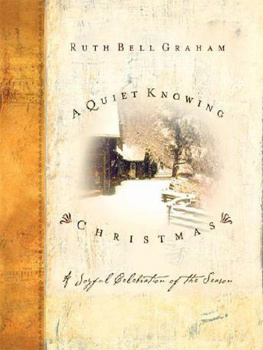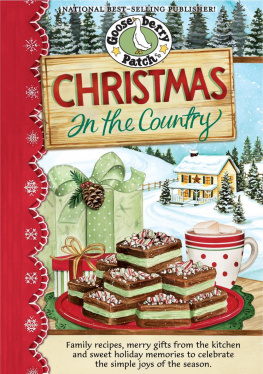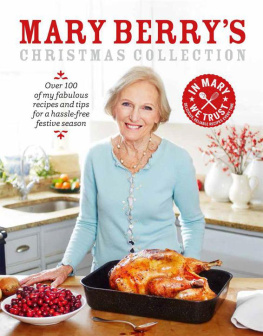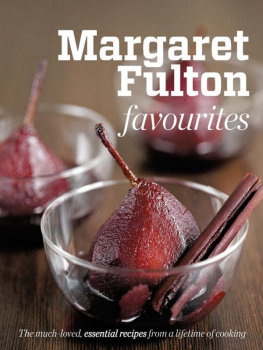contents
Margaret Fulton
What shall we have for Christmas dinner this year? Every December the family discussion turns to this. Our whole family sits around the table planning our Christmas feast its the most joyous meal of the year, so we want to get it right. To help you with this great quest, Ive gathered my very best recipes for the dishes that take pride of place on the Christmas table, as well as all the trimmings, vegetables, salads, puddings and drinks.
You might like to start with a salmon and asparagus terrine, followed by a stuffed turkey breast with crispy roasted vegetables, then my famous Christmas pudding for dessert. Yum! And lets not forget some lovely gingerbread men and shortbread for the best Christmas gift you could possibly give.
A very merry Christmas to you all!
Margaret
The traditions of Christmas
Every country, village and family is a law unto itself as to how Christmas is celebrated what we eat, when the tree goes up (and comes down), which decorations are favoured, when we open the presents and when we put on our paper hats, pull the Christmas crackers and read out the message inside. I find it fascinating to know the traditions behind Christmas and why they are kept alive.
Advent
Advent, the four weeks that lead up to Christmas, starts the Christmas festivities. In Sweden, families go to church to sing carols and people decorate their homes and streets. In Germany, the advent wreath is hung in the window, with its four red candles lit. In Provence, a handful of seed corn is scattered on a piece of wet flannel, which is set by the fire to germinate in time to decorate the table for Christmas Eve. And in Rome and Naples, bagpipe players come down from the mountains to play haunting tunes before the many street shrines where lamps are kept burning on the first Sunday in Advent.
St Nicholas
The eve of 6 December, the Festival of St Nicholas, is the traditional present-giving day over much of northern Europe. St Nicholas was originally the patron saint of sailors and later took care of children as well and, like Santa Claus, slipped gifts to young favourites under cover of darkness. Dutch families hide presents all over the house in the lead-up to St Nicholass Eve. Marzipan is the great treat and, in preparation, Dutch pastry shops blaze with beautiful marzipan fruits and delicious spiced biscuits and cakes.
Sinte Klaus and Santa Claus
In the 17th century the Dutch Sinte Klaus migrated to the US. He was re-exported back to Europe as the incarnation of the polar-based Santa/Father Christmas we know today red jacket with snowy trim, with Rudolf and sleigh in tow.
Christmas in Germany
When Queen Victoria married Prince Albert, he brought some of the German traditions to England, which we have, in turn, absorbed. The Christmas tree, with its decoration of small, lit candles, was one of these customs, as was the habit of stacking presents around the base of the tree. Christmas presents date from the 1500s, when the infant Jesus would send a sackful of presents to be given out. Each child gets five presents: something delicious to eat, something to learn with, something to spend, something to play with and something new to wear.
In Germany, Christmas Eve is the night for magic and present giving, when forests blossom and the pure of heart can understand the language of animals. This witching hour extends into the twelve days between Christmas and Epiphany.
The festive foods of Europe
Throughout Europe the assortment of festive dishes to celebrate the happy season is incredible. Christmas treats like ricciarelli, panforte and marzipan fruits make wonderful gifts for Christmas. Spices featured in much of the Christmas food in the 1500s as the sailors and traders ventured to the Spice Islands and brought back a rich harvest.
In France they celebrate with a yule log (bche de Nol). The origin of the yule log is believed to be derived from the old custom of sending a log to your hosts house on Christmas Eve so you could be sure to enjoy the Christmas dinner before a roaring fire. In Holland the festive season would be most disappointing without the spicy speculaas biscuits, and no self-respecting Scot would bring in the new year without shortbread. Throughout Scandinavia, Germany and Austria, children rush to bake and decorate the gingerbread men or the angels or stars made from a spiced biscuit to hang on the Christmas tree. Stollen is the traditional German Christmas fare a rich fruit bread, it is either dusted with icing sugar or painted with a thin white icing. The Scandinavian cold table is taking a big hold in countries like Australia, especially when temperatures can be scorching.
Twelfth Night
Twelfth Night, the night that precedes Epiphany, is the eve of the day the Three Wise Men arrived in Bethlehem to lay their gifts before the Holy Infant. Lucky Mediterranean children enjoy two festivals of gift-giving the celebrations on 25 December and Twelfth Night. In Italy, Befana, the kind witch who walks on the rooftops, brings toys to good children and rods to naughty ones on Twelfth Night. In France, Epiphany is celebrated with a pastry in which a bean or ceramic figure is hidden whoever gets it is king for the day and wears the golden crown the cook mounts on the cake.
All good things must come to an end. On the Twelfth Night, which falls on 5 January, we take down the Christmas tree and decorations. The rich cakes and spicy biscuits served bring the festivities to a rousing conclusion.
Christmas time means turkey with all the trimmings, ham glazed to glittering perfection, puddings full of plump fruits, little treats like spiced cookies, biscuits, nougat and nuts. With so much to take care of, the last thing the cook often thinks of is little nibbles, snacks and a first course or starter.
A few nuts, good olives and some piping hot pastries stored in the freezer are very useful come Christmas morning. In recent years, smoked salmon and gravlax have been readily available, and along with baby mixed greens, good rye or black breads or last-minute blinis (Russian pancakes), have been a mainstay for such times. For some, oysters are the ultimate treat. Most of us enjoy the surprise element of a little bite-sized nibble to enjoy with a drink to break the ice.
It is always a great pleasure to sit down to an inviting plate, perhaps very thin slices of smoked salmon, some quarters of lemon and brown bread and butter, or some simple and light dish that will stimulate, but not destroy, the appetite and set the mood for the delicious meal to follow.
Although a selection of recipes follows, there is an infinite variety of ways that they can be presented. It is a simple matter to select what will be the perfect way to start your Christmas celebrations on the right note.
Blinis with Smoked Salmon or Gravlax
Makes about 24
This is a perfect treat before Christmas dinner or any other dinner or lunch for that matter. Our family requests Robert, my son-in-law, make his very excellent gravlax as a special treat, which he makes 2 or 3 days ahead. A batch of proper little Russian pancakes blinis made with buckwheat flour is made just before we eat, and he also makes a creamy horseradish sauce by adding 1 tablespoon horseradish to 4 tablespoons crme frache or light sour cream. Smoked salmon or gravlax can be served on dark rye or black bread as a little pre-dinner savoury or at a drinks party as an alternative to blinis.




